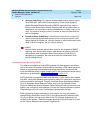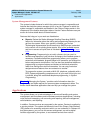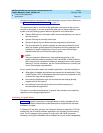
MERLIN LEGEND Communications System Release 6.0
System Manager’s Guide
555-660-118
Issue 1
February 1998
Features and Applications
Page 4-54Features
4
calling supervisor
. When too many calls are waiting for a calling group, calls are
sent to an
overflow receiver.
In Release 4.0 and later systems, waiting calls can
be sent to the overflow receiver based how long callers have been waiting or how
many callers are waiting. In Release 6.0 and later systems, callers can choose
overflow treatment if the system has been programmed to allow this.
The system has numerous features and settings to support calling groups:
■ Hunt type determines whether calls go in a circular pattern (circular hunt
type) to the first available group member, whether calls are distributed
based on which agent has waited the longest since transferring or hanging
up on an incoming calling group call (most idle agent hunt type, Release
5.0 and later systems only), or whether all calls go to one group member
and reach others only when the first person is unavailable (linear hunt
type).
■ In Release 6.0 and later systems, you can limit the number of calls in the
main calling group queue. This applies to or calls arriving on PRI dial-plan
routed facilities, dial-in tie trunks, or DID trunks or calls transferred from a
voice/mail auto attendant application, and Group Calling calls. When the
number of queued calls reaches the limit (0–99), subsequent callers hear a
busy signal. Queue control does not apply to coverage calls, remote-
access calls, or calls arriving on other types of lines/trunks. If a call is
transferred with consultation, it is not queued. These calls can still join the
queue when the limit has been reached or exceeded.
■ Extensions and supervisor positions can be programmed to log group
members in or out (automatically or manually) for the purpose of receiving
calls or stopping calls to the extension.
■ The light on a Calls-In-Queue Alarm button on a phone goes on when too
many calls are waiting for the group. In Release 5.0 and later systems, the
system manager or calling group supervisor can specify up to three alarm
levels to indicate increasing severity.
■ Other extensions or an operator can provide coverage when all the group
members are unavailable and too many callers are waiting.
■ Calls can be sent to the operator or calling group who provides coverage
(the
overflow receiver
) when callers have waited too long (time-based
overflow), when too many callers are waiting (number-based overflow),
and/or when a caller asks to stop waiting for an agent via touch-tone input
(prompt-based overflow available in Release 6.0 and later systems; see
the next item for more about delay announcements).
■ A delay announcement device can be programmed to play a recording that
describes a delay to waiting callers. In Release 5.0 and later systems, a
secondary device and message can be set up for each group, allowing
callers to hear a primary message first, then a secondary message that
may repeat. In addition, as many as 10 primary delay announcement


















